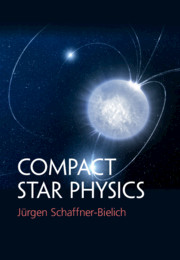Refine listing
Actions for selected content:
17000 results
Preface
-
- Book:
- Compact Star Physics
- Published online:
- 17 August 2020
- Print publication:
- 27 August 2020, pp xi-xii
-
- Chapter
- Export citation
13 - Properties of Stars
-
- Book:
- Foundations of Astrophysics
- Published online:
- 18 September 2020
- Print publication:
- 27 August 2020, pp 307-335
-
- Chapter
- Export citation
Contents
-
- Book:
- Compact Star Physics
- Published online:
- 17 August 2020
- Print publication:
- 27 August 2020, pp vii-x
-
- Chapter
- Export citation
21 - Active Galaxies
-
- Book:
- Foundations of Astrophysics
- Published online:
- 18 September 2020
- Print publication:
- 27 August 2020, pp 489-510
-
- Chapter
- Export citation
10 - The Planets
-
- Book:
- Foundations of Astrophysics
- Published online:
- 18 September 2020
- Print publication:
- 27 August 2020, pp 232-265
-
- Chapter
- Export citation
References
-
- Book:
- Compact Star Physics
- Published online:
- 17 August 2020
- Print publication:
- 27 August 2020, pp 295-305
-
- Chapter
- Export citation
2 - General Relativity
-
- Book:
- Compact Star Physics
- Published online:
- 17 August 2020
- Print publication:
- 27 August 2020, pp 8-37
-
- Chapter
- Export citation
Bibliography
-
- Book:
- Foundations of Astrophysics
- Published online:
- 18 September 2020
- Print publication:
- 27 August 2020, pp 583-584
-
- Chapter
- Export citation
11 - Small Bodies in the Solar System
-
- Book:
- Foundations of Astrophysics
- Published online:
- 18 September 2020
- Print publication:
- 27 August 2020, pp 266-289
-
- Chapter
- Export citation
Frontmatter
-
- Book:
- Compact Star Physics
- Published online:
- 17 August 2020
- Print publication:
- 27 August 2020, pp i-iv
-
- Chapter
- Export citation
Frontmatter
-
- Book:
- Foundations of Astrophysics
- Published online:
- 18 September 2020
- Print publication:
- 27 August 2020, pp i-iv
-
- Chapter
- Export citation
23 - Cosmology
-
- Book:
- Foundations of Astrophysics
- Published online:
- 18 September 2020
- Print publication:
- 27 August 2020, pp 526-550
-
- Chapter
- Export citation
Contents
-
- Book:
- Foundations of Astrophysics
- Published online:
- 18 September 2020
- Print publication:
- 27 August 2020, pp v-x
-
- Chapter
- Export citation
6 - Astronomical Detection of Light
-
- Book:
- Foundations of Astrophysics
- Published online:
- 18 September 2020
- Print publication:
- 27 August 2020, pp 146-171
-
- Chapter
- Export citation
A - Astronomical Data
-
- Book:
- Foundations of Astrophysics
- Published online:
- 18 September 2020
- Print publication:
- 27 August 2020, pp 575-582
-
- Chapter
- Export citation
Preface
-
- Book:
- Foundations of Astrophysics
- Published online:
- 18 September 2020
- Print publication:
- 27 August 2020, pp xi-xii
-
- Chapter
- Export citation

Compact Star Physics
-
- Published online:
- 17 August 2020
- Print publication:
- 27 August 2020
5 - Numerical Integration
-
- Book:
- Gravitational Few-Body Dynamics
- Published online:
- 06 April 2020
- Print publication:
- 16 April 2020, pp 55-80
-
- Chapter
- Export citation
8 - Algorithmic Regularization
-
- Book:
- Gravitational Few-Body Dynamics
- Published online:
- 06 April 2020
- Print publication:
- 16 April 2020, pp 173-210
-
- Chapter
- Export citation
Contents
-
- Book:
- Gravitational Few-Body Dynamics
- Published online:
- 06 April 2020
- Print publication:
- 16 April 2020, pp vii-x
-
- Chapter
- Export citation
